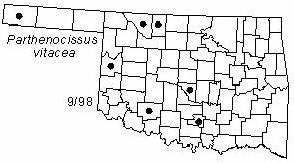Woody vine, climbing by branched tendrils without adhesive appendages. Leaves long-petioled, palmately compound. Leaflets usually 5 (3-7), elliptic to obovate, to 15 cm (6 in) long and 8 cm (3 in) wide, acuminate, coarsely serrate above the middle of the blade, glabrous and shiny green above, paler and sometimes pubescent below. Inflorescence dichotomously branched. Flowers small, numerous, yellowish-green, blooming in late Spring or early Summer. Fruits black or dark blue drupes, globose, 10-12 mm (0.4-0.5 in) in diameter, with 1-3 seeds, ripening in Fall.
Distribution: Native to much of the U. S. except the southeast and northwest.
Habitat: Bottomland forests, oak-hickory forests, Cross Timbers.
NWI status: FAC
Comment: Woodbine is very similar to Virginia creeper (P. quinquefolia). The differences are in the tendrils and the branching pattern of the inflorescence. Parthenocissus is from a Greek phrase meaning "virgin ivy"; vitacea refers to the grapelike tendrils.
Distribution in Oklahoma: 
BACK
NEXT
RETURN TO INDEX
Last update: 9/15/99
 Go to Oklahoma Biological Survey Home Page
Go to Oklahoma Biological Survey Home Page
 Disclaimer
Disclaimer